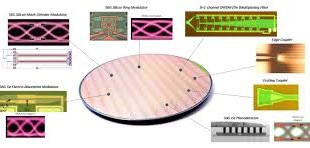Despite their airborne maneuverability, helicopters, with their skid-or-wheel landing gear, still need a level surface to set down which are scarce in combat and rescue missions. Landing on an uneven surface could them to tip over or the rotor blades to come into contract with the ground resulting in disaster. And there are plenty of uneven surfaces on battlefields, ships and disaster areas.
Researchers with the Defense Advanced Research Projects Agency and the Georgia Institute of Technology are developing a system that would give helicopters the ability to handle rugged terrain or moving surfaces (such as ship being tossed in roiling waters). DARPA recently demonstrated a new robotic landing gear system in an unmanned flight near Atlanta, Georgia, “The equipment—mounted on an otherwise unmodified, unmanned helicopter—successfully demonstrated the ability to land and take off from terrain that would be impossible to operate from with standard landing gear,” said Ashish Bagai, DARPA program manager. The adaptive system consists of a four-legged undercarriage that replaces the standard landing gear. The effect is four independently articulated legs that fold up against the fuselage of the ship after takeoff and extend on landing.
Each leg has a force-sensitive contact sensor in its foot and all four are designed to work in concert as a computer makes real time calculations of the best angles to set the legs in order to keep the ship level and stable, without risking the rotor hitting the ground. Each leg would then extend and then react individually to the surface it comes in contact with, flexed in a different position when it lands—depending on the surface—keeping the helicopter itself level.
Mark Costello, the Georgia Tech aerospace engineer and professor of autonomy who has led the project over the past two years explained that the version in the video relies on eight electric motors to activate four joints — two hips and two knees. When a special film on the bottoms of the “feet” is subjected to pressure by the foot touching an object, the resistance of the electric circuit changes, activating the joints to bend and equalize the pressure on all four feet. “It’s electricity that makes it move,” Costello said. His team calculates that replacing skids with adaptive landing gear in small to medium-class helicopters would reduce their payload by about 7 percent. Replacing wheels would be about an even weight trade, he said.
Bagai said there are significant advantages to using the robotic landing gear, including that it would reduce the risk of damage from hard landing by a factor of five. DARPA’s Bagai said pneumatic and hydraulic versions of the four-legged gear have been studied, too, and would be necessary for aircraft much heavier than the 250-pound Rotor Buzz used in the video. The gear also will allow for stable take-offs and landing on slopes of up to 20 degrees—more than twice what’s possible with conventional landing gear—as well as on storm-tossed ships. All these advantages come with only a small increase in the landing gear weight, Bagai said.
Critics question Mission Robustness
Veteran combat pilots Brady and Greene questioned how a helicopter equipped with DARPA’s landing legs would do in a “running” takeoff or landing, a maneuver required when helicopters of the sort they flew suffer hydraulic failures, which bullets can cause, “I would wonder how robust that puppy would be,” Greene said as reported by Richard Whittle in Breaking Defence. “I’m suspicious of mechanical devices that have to go up and down. When you add mechanical things, the opportunity for failure presents itself. And what happens if one side fails? You could conceivably hit the ground with your rotor.”
Bagai said the critics “make very good points” but he and Costello emphasized that the project is simply exploring the possibilities. Adaptive landing gear, perhaps coupled with a deck lock system, could greatly increase the sea state levels at which helicopters can land aboard ships, Bagai said, or make it possible for a helicopter to take off and land from a moving trailer in a convoy. Costello added that, “Our analysis suggests that pilots will be able to land in complex situations faster with lower pilot work load.” But not any time soon. “This is … in the spirit of DARPA investigation and technology development,” Bagai said. “This is the first step to recognizing a potential improvement.”
Roger Connor, rotorcraft curator at the National Air and Space Museum said DARPA’s gear might work just fine on a light, unmanned helicopter and be especially helpful for one flying autonomously. It’s generally much easier for a human being than a computer to detect obstacles in a landing zone. “This is a technology that…allows helicopters to operate in situations where you would normally have to have a very skilled pilot,” Connor said. “Amazon, I would think, would be very interested in this technology if they’re serious about delivering packages in certain locations.” The new robotic landing gear is currently under development by the Georgia Institute of Technology under funding from DARPA’s Mission Adaptive Rotor (MAR) program.
DARPA’s Mission Adaptive Rotor (MAR) program
Current military conflicts have clearly demonstrated the essential role of the helicopter in achieving U.S. military objectives. Vertical flight has proven indispensable for transporting critical personnel and supplies safely and efficiently, offers basing flexibility critical to unconventional operations and modern combat, enables operations in complex terrain, and provides vital airborne firepower to protect our troops. Although current systems have proven themselves to be workhorses, helicopter operations are currently performance-limited in mountainous terrain and deserts. In addition, general helicopter performance characteristics have not experienced a significant advance since the introduction of the turboshaft engine in the 1950s.
Recent rotorcraft research and analysis has indicated that significant performance benefits could be achieved by actively morphing the shape or properties of the rotor system. Active rotor technology will enable morphing of the rotor to optimize performance, resulting in rotorcraft with revolutionary advances in mission robustness, and facilitating multi-role capabilities. In addition, active rotors with on-blade blade control could enable elimination of the rotor swashplate, potentially with significant improvements in performance, survivability and availability. Numerous component morphing technologies have been demonstrated at the component level that could provide incremental improvements, but these technologies have not been implemented at a system level for revolutionary capability improvements.
The goals of the MAR program are to develop and demonstrate morphing rotor technology and demonstrate the dramatic benefits possible using this capability. The MAR program seeks to: 1) develop a robust design for a morphing rotor system that maximizes military utility by reconfiguring the system; 2) mature critical enabling technologies; and 3) validate through simulation, ground test and flight demonstration that rotor adaptation and morphing is feasible, practical, of military value, and sufficiently mature for application to the next U.S. military rotorcraft development effort.
DARPA expects to make investments in key component technologies – including, for example, actuators, sensors, controls and materials – as well as system architecture and novel rotor geometry adaptation approaches, in order to enable breakthrough capabilities. A MAR technology demonstrator rotor may provide the technical basis for application of adaptive rotors to the next generation of military rotorcraft.
 International Defense Security & Technology Your trusted Source for News, Research and Analysis
International Defense Security & Technology Your trusted Source for News, Research and Analysis

